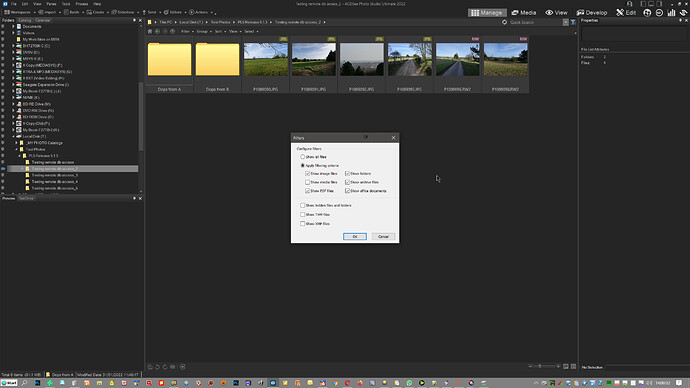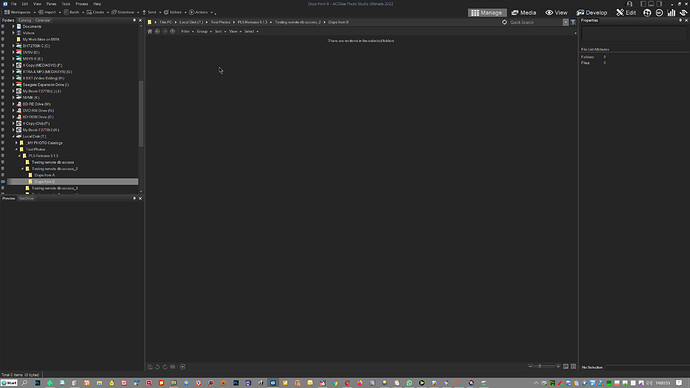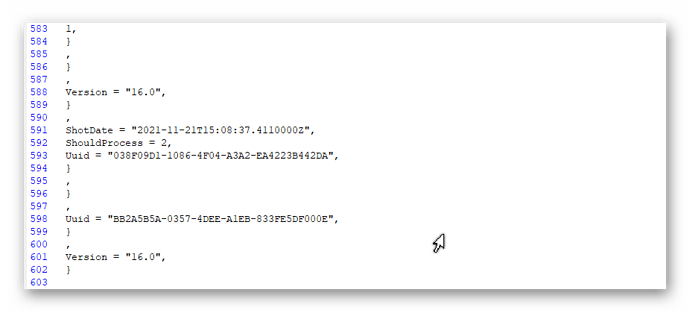Hello. Each pictures that i have opened in DXO Lab appear now in my ACDsee program twice one showing the picture and having exif datas and another with a PL Logo and no exif datas. It is very ennoying because the PL files are named wit .JPG or .arw and so they are processed by ACDsee like regulars pictures. What can you tell me about it. have you any advices? Thank you.
Welcome, Yves.
Please post a screenshot so we can see/identify the files you’re speaking about.
I’m guessing they’re sidecar/.dop files … but cannot be sure from your description.
Regards, John M
@John-M is correct. These are sidecar files which have a .dop extension and which contain all the editing information for the image file. You would need to filter them out in ACDSee.
@YvPL5 Go to ‘Filter’/‘Advanced Filter’ and check ‘Apply filtering criteria’ and turn off ‘Show Media files’ will fix it but experiment with the settings in there if you suddenly lose something else that you actually wanted showing!
The following is a directory full of DOPs but the filter makes them “vanish”!
You re great. This is the right thing to do in Acdsee not to see the .dop files.
I thank you a lot and the others to help me so well.
Now i wonder what are theses .dop files but this another subject. … 
They are “sidecar” files - containing details of all the corrections you made to each image.
They are named to match (sort of) with the image to which the corrections relate.
For example, if you were to delete your database then PL will be able to recreate it from the details held in the sidecar/.dop files … EXCEPT for Keywords and Project details (which are NOT held in sidecar files).
John
@YvPL5 you are welcome and @John-M is mostly correct in his statement about the contents of the DOP, certainly with respect to its contents for practical purposes, i.e.
The simplest way to get some idea of what is in a DOP (.dop sidecar) is to open one in a text editor but do not make changes and then save it back (unless you are “hacking” DOPs to test a theory!!)
The DOP can contain keywords and ‘Ratings’ both of which are .xmp data and typically reside in the photo (image) file for JPGs and in an .xmp sidecar file for RAW images (some software can put the keywords and ‘Ratings’ directly into the embedded xmp fields of a RAW images but PL5 uses the .xmp sidecar file which is also accessible with a text editor!!).
However, the ‘Keyword’ and ‘Rating’ held in the DOP will not be read back by PL5, the 'Tag. (accept/reject/untagged - green/red/grey) is a PL5 attribute and is stored in the DOP to be read back by PL5 but currently there appears to be a bug!!)
However, John-M is absolutely right about the ability to use the DOP sidecar files to recover your edits (and Tags when the bug is fixed) from the DOP which are effectively a copy of the data stored in the PL5 database. There are many issues that have been discussed over many posts about what happens if you attempt to navigate to the same image in the same directory with a DOP created on another machine, just search for Virtual Copies in the Forum.
If you want to discuss your proposed method of processing your images (your workflow) then the Forum is a good place to receive comments.
Here is a section of a DOP
and the Tail end looks like
The 'ShouldProcess field is the ‘Tag’ I referred to earlier and the Uuid field immediately behind it is the “key” that must match the corresponding “key” in the database to signal this is the correct DOP for the database entry. If you are recovering a “lost” database or lost (deleted) files etc. then the DOP data will be used to (re)create the entry in the database. If the keys do not match then “both” will be “accepted” but as two copies the [M]aster and [1] Virtual Copy.
Virtual copies are very useful to try out various edits for a particular image.
Have fun!



